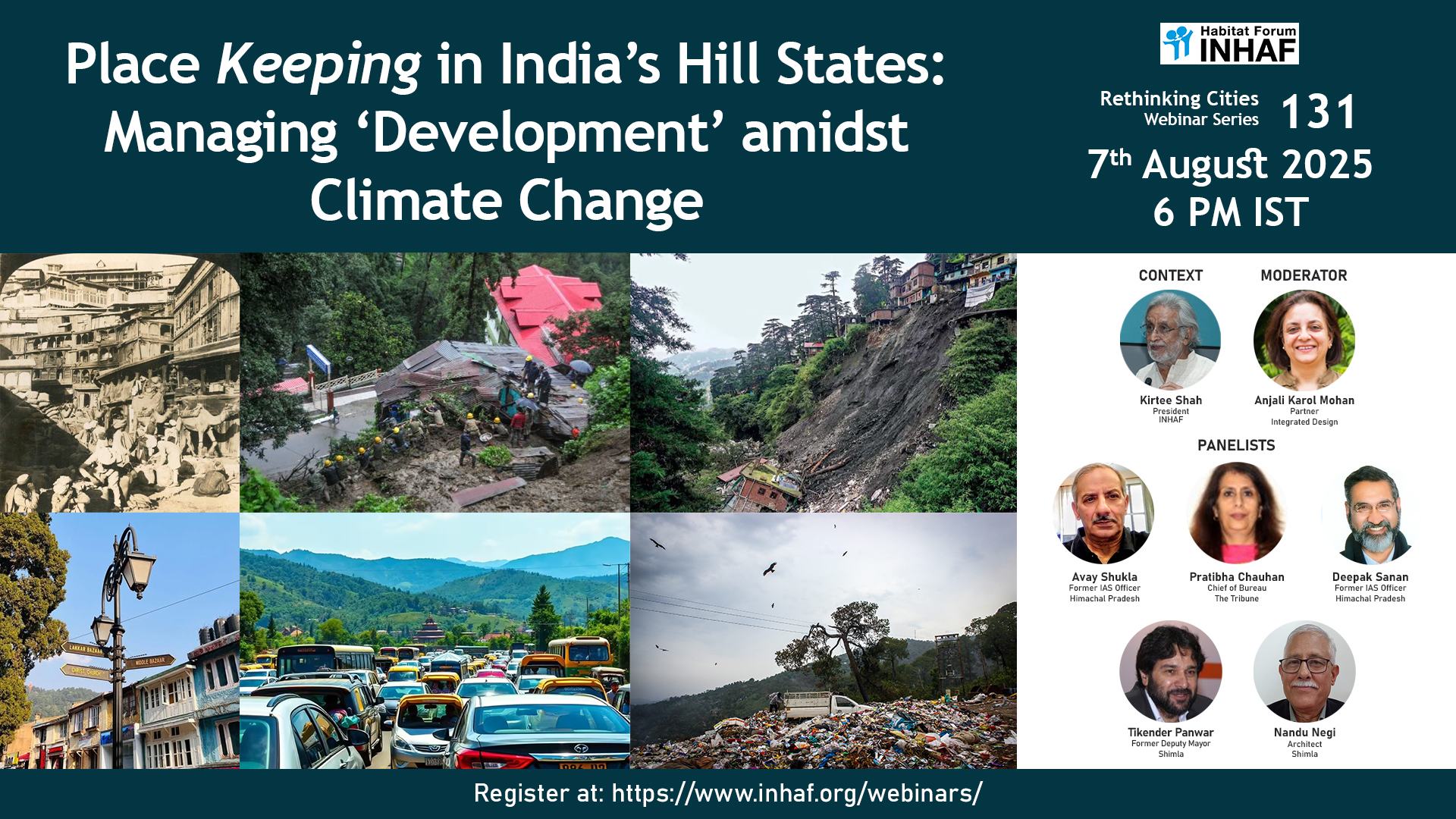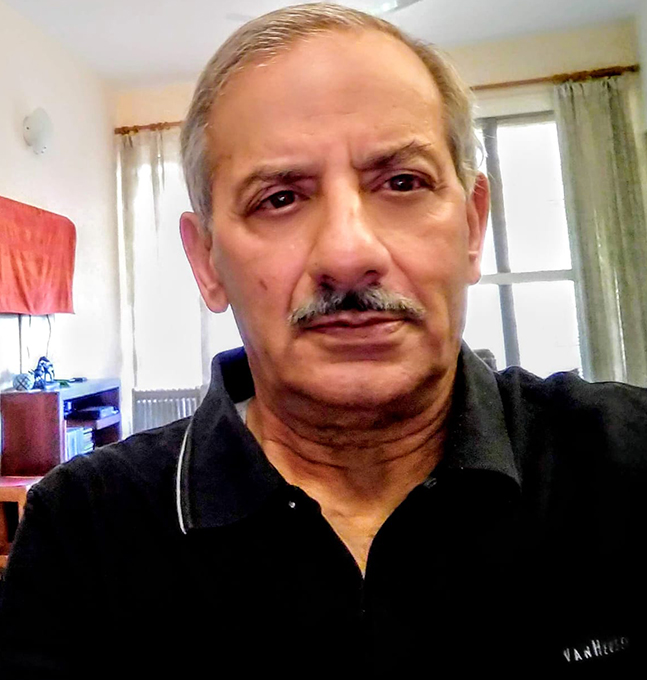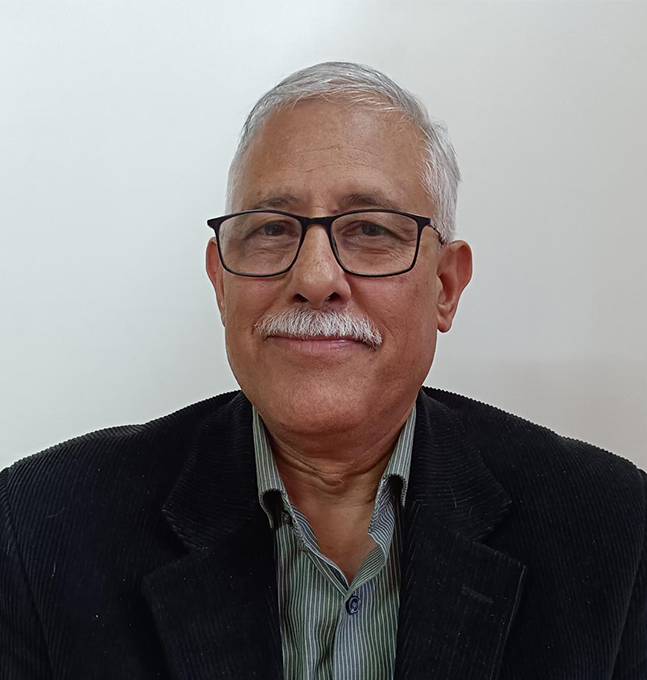
Speakers
-
 Avay ShuklaFormer IAS Officer, Himachal Pradesh
Avay ShuklaFormer IAS Officer, Himachal PradeshAvay Shukla is a retired officer of the Indian Administrative Service (IAS), an environmentalist, and a writer.
He obtained his Master’s degree (English) from Hindu College, Delhi, in 1973. He taught for two years at Delhi University, before joining the Indian Administrative Service in 1975. He served in Delhi and the Indian Himalayan state of Himachal Pradesh in various capacities. He retired from the IAS in December 2010, completing his official duties as the Additional Chief Secretary of Himachal Pradesh.
He is the President of the Himachal Pradesh Trekking Association, and is one of the founding members of the Eco-Tourism Society of India.He has settled in a village, Puranikoti, above Shimla and divides his time between that and Delhi.
Avay Shukla writes extensively on current affairs, environment and conservation, bureaucracy and governance, legal matters, social issues, societal peccadilloes and more. His work has been published in The New Indian Express, The Times of India, The Hindustan Times, The Tribune, National Herald, The Morning Standard and on websites such as Sify.com, The Wire, The Citizen and Hillpost.com.
-
 Deepak SananFormer IAS Officer, Himachal Pradesh
Deepak SananFormer IAS Officer, Himachal PradeshDeepak Sanan is a Senior Visiting Fellow at CPR. Major areas of his interest include public policy in the areas of state capacity, land governance, public finance, water and sanitation.
He is a former civil servant, living in Himachal Pradesh. He retired from the Indian Administrative Service, the centrally recruited senior civil service of India in January 2017. He was allocated to the state of Himachal Pradesh. His other current affiliations include advising at the National Council of Applied Economic Research (NCAER), Delhi and the Indian Institute for Human Settlements (IIHS), Bangalore on a variety of subjects related to his experience and special interests. In particular, he heads the Centre for Land Governance at the IIHS and the Land Policy Initiative at NCAER.
Sanan has published regularly on public policy issues with an interest specially in creating incentives to more effectively use Central funds to overcome State budget constraints and improve governance. He has a special interest in designing schemes of inter-governmental financial transfers that can improve institutional arrangements at state and local government level to enhance the effectiveness of these transfers and service delivery especially in basic services. He has undertaken many assignments over the years as a consultant with the World Bank, The International Fund for Agricultural Development (IFAD), The Department for International Development (DFID), The Institute of Development Studies (IDS Sussex) and AusAid relating to his skills and experience in public finance, urban and rural development and especially in relation to the water and sanitation sector in India. He has also been on the staff of the World Bank as the India Country Team Leader in the Water and Sanitation Program (South Asia) for two years between 2005 and 2007.
Sanan has completed an MA Politics (International Relations) from Jawaharlal Nehru University, Delhi in 1979 and a BCom (Hons) from Sri Ram College of Commerce, Delhi University in 1977.
-
 Dr. Anjali Karol MohanPartner, Integrated Design
Dr. Anjali Karol MohanPartner, Integrated DesignDr. Mohan is a Partner at Integrated Design (https://www.integrateddesign.org) where she leads urban planning projects as well as initiatives at the intersection of planning, participation, development and environment. Dr. Mohan is involved extensively in action research in Bhopal, Ranchi, Dharwad, Delhi and Bangalore to evolve city-region, city and neighbourhood scale climate change responsive planning frameworks that focus on resilient and liveable cities. These projects are funded by the Adaptation Research Alliance, Nudge Research Innovation Grant, Selco Foundation and ELRHA, UK amongst others. Her professional experience over the last three straddles development, institutional and policy frameworks, urban planning and management and information and communication technologies and development (ICTD). She has successfully completed several planning assignments in her individual capacity and as part of multi-disciplinary teams, both as a team leader and a team member. She is a faculty at the Centre for Public Policy at the National Law School University of India, Bangalore, Kautilya School of Public Policy, Gitam University, Hyderabad and the Takshashila Institutions. Dr. Mohan has published in academic journals as well as popular media, in addition to delivering talks and presenting her work globally. She is a member of the Copenhagen-based International Federation for Housing and Planning and has served on several task forces and expert committees. Most recently, she was a member of the Expert Panel to the Chief Minister of Andhra Pradesh advising on a state wide Comprehensive Urban Development Strategy.
-
 Nandu NegiArchitect, Shimla
Nandu NegiArchitect, Shimla -
 Pratibha ChauhanChief of Bureau, The Tribune
Pratibha ChauhanChief of Bureau, The TribunePratibha Chauhan is the Chief of Bureau for Himachal Pradesh at The Tribune, with over 25 years of experience in journalism. Based in Shimla, she is known for her in-depth coverage of state politics, environmental issues, and the socio-cultural developments of the region. She holds a Ph.D. focused on environmental issues related to the development of Himachal Pradesh, which complements her reporting on ecological concerns and sustainable development. Pratibha has consistently delivered timely and insightful stories, including extensive coverage on natural disasters, state-level political dynamics, and agricultural innovations like hemp farming. Her reporting is widely recognized for its clarity, depth, and regional relevance. She is also active on social media and uses her X (formerly Twitter) handle to engage with readers and share real-time updates.
-
 Tikendar PanwarFormer Deputy Mayor, Shimla
Tikendar PanwarFormer Deputy Mayor, ShimlaTikender Panwar is the Former and only directly elected Deputy Mayor of Shimla. He is currently a member of the Urban Policy Commission of Kerala, National convenor of the National Coalition for Inclusive & Sustainable Urbanisation and a Senior Fellow at IMPRI. He was also a member of the national task force in the country to review the 74th constitutional amendment. He is also a published author.
Local Time
- Timezone: America/New_York
- Date: Aug 07 2025
- Time: 8:30 am
Place Keeping in India’s Hill States: Managing ‘Development’ amidst Climate Change
Context
Since their conception under the British Raj government, India’s hill stations are regarded as escapist havens, boasting salubrious climates, picturesque landscapes and seclusion from the chaos of the plains. Post independence, most hill stations have continued to grow as tourism hotspots —while simultaneously experiencing increases in size and strain. Under the British Raj, these areas were earmarked as retreats during the summer months, and as sanitaria for recuperation and recreation. Further colonial dominance took form in these areas serving as strategic military locations, where cantonments and residences of government dignitaries were built, thus granting them administrative significance. Post-independence, this dominance was adopted by India’s elite classes, wherein hill station getaways were and continue to be an activity exclusive to the affluent. However, the mid-1980s and onwards saw increased access to different socioeconomic groups due to hill station expansion; leave travel grants in the government and public sector; and the transition to a car-centric society. What were once strategically secluded locales designed for a limited population – driven by a hyper fixation of planning and governance bodies on place-making – are favorable tourist destinations, with increased infrastructure and built-up area aided by local businesses and monied classes. Place-making, in this context, is a reactive practice that asserts the economic and social benefits of the spaces and infrastructure being made—for instance, reductions in travel time or improved mobility and accessibility to these once secluded hill stations.
The Fragile Mountain Ecosystems
Mountain ecosystems, characterized by steep slopes, irregular topography, fragile soil composition and geological instability, are reportedly under threat – from extrinsic and intrinsic pressures. For instance, all districts in Himachal Pradesh were placed on high alert in a press release issued on June 26th, with heavy rainfall triggering landslides, flash floods and widespread disruption, coupled with infrastructure damage. National highways were blocked while damaged roads disrupted services and power outages. Notably, this was preceded by an extended heatwave, where multiple hill stations experienced maximum temperatures that significantly exceeded normal levels. In Uttarakhand, similar extremes can be observed in July 2025, where multiple districts are experiencing incessant rainfall that has triggered widespread landslides and led to the closure of around 61 roads state-wide. Only months earlier, the state also experienced an especially dry winter with 89% of districts suffering from little or no rain or snow.
Alongside extrinsically driven growth, hill state capitals have also undergone intrinsic pressures, assuming primacy as they host infrastructure and services that service a larger hinterland. For instance, as of 2017, while Shimla hosts 25% of Himachal Pradesh’ urban population, it houses significant development infrastructure and growth potential. The unpredictability and heterogeneity of these hill-station landscapes exacerbate the relative scarcity and consequent importance of available and newly developing infrastructure. In this sense, development and urbanization are a necessity. Yet, the confluence of historical precedents and contemporary trends are coalescing to forge a path towards extreme climate vulnerability bordering on unviability.
The current expansion in the hill stations is spurred by a free-for-all style of development where construction is occurring wherever perceivably free space is available. This has spurred both vertical and horizontal development: marking a shift from low-density and low-rise built-area to high-density and high-rise growth while also moving outwards from the urban core to the periphery. The unique geophysical settings of these expanding cities also means that land is increasingly scarce, and that available land is characterized by extremely high prices. Cumulatively, rampant and unobstructed concretization and growth of built-up areas that fragments the natural landscape, reduces green cover and alters the ecological balance of these areas is an observable trend. On the planning side, many of these hill stations suffer from
mismanaged growth due to their unique geophysical settings, with plans that are not predicated on these characteristics. For one, there is a significant lack in building bylaws and guidelines for hill town development specifically. Existing building regulations are inspired by the National Building code and Delhi’s Master Plan—completely disjointed from the geo-environmental and socio-developmental context of hill towns. This lack of flexibility manifests in highly rigid regulations that neglect topographical location; slope angle and direction; hazard potential; and development patterns and potential.
Shimla’s Challenges
A critical example of these culminating issues can be seen in Shimla. Here, the first statutory Interim Development Plan was notified in 1979, in accordance with the Himachal Pradesh Town and Country Planning Act (1977) and Rules (1978). While numerous amendments were made in between to meet changing demands, no development plans were available for the decade of 2001 to 2011—with development having occurred on a purely reactionary basis in response to tourist and local demands. The plan for 2021 was approved in 2012 followed by the current Shimla Development Plan for 2041 receiving approval in 2022. The 2041 plan includes areas around Shimla such as Kufri, Shoji and Ghanahatti, and additional villages – positioned as satellite towns to be developed to meet the expanding needs of Shimla while retaining its ecologies. However, this plan suffers from numerous inadequacies. Most concerningly, the plan is not premised on the load-bearing capacity of Shimla’s slopes. The city has expanded on slopes exceeding 60 degrees despite a permissible limit of 45. The plan also permits construction in core, non-core and green areas, as well as vertical development on these slopes. Shimla’s governing bodies also continue their attempts to bolster tourism through the opening of “unexplored” locations. approval of tourism-related projects and loans, numerous highway projects, and hydropower projects that have already changed local terrestrial ecosystems. The story is not any different for other hill stations that are inherently characterized by a certain degree of climate vulnerability. ‘Growth and development’ including rapid urbanization has transformed hazards into outright disasters. In the ceaseless attempts to capitalize on tourism potential, erroneous place-making has taken precedence over more intentional and prospective forms of place-keeping—many of which would involve a paradigm shift towards centering ecological and environmental elements that do not have perceivable economic value.
Moving Ahead
The question that then assumes significance is on how to limit (and reimagine) the current model of ‘growth and development’ to achieve a balance between development as a necessity while limiting it to preserve the uniquely fragile and precarious ecosystems. Would a shift amongst the adjacent principles of place-making to place-keeping provide an entry point to the much needed course correction. In place-keeping, the focus lies not in the shaping or making of spaces, but in their strategic long-term maintenance and management to ensure sustainable and intentional growth.
Infrastructure resilience, elevation-sensitive planning, conversation buffers along growing transport corridors, and detailed topographic, ecological and socioeconomic assessments, restoration of forested areas amongst others are the foregrounded solutions. While laudable, their achievement is premised on strengthening planning and governance bodies while distributing the burden the burden of centralized planning through a polycentric, bottom-up approach that prioritizes local technologies and knowledge. More controversially, it is also worth considering policy shifts regarding the permissible extent of tourism, eco-taxes and other means of limiting influx. Ultimately, the place keeping of India’s hill stations is contingent on recognizing the distinction between necessary development that truly bolsters efficiency and prosperity in these cities, and myopic and mismanaged growth that encroaches upon already fragile landscapes.
